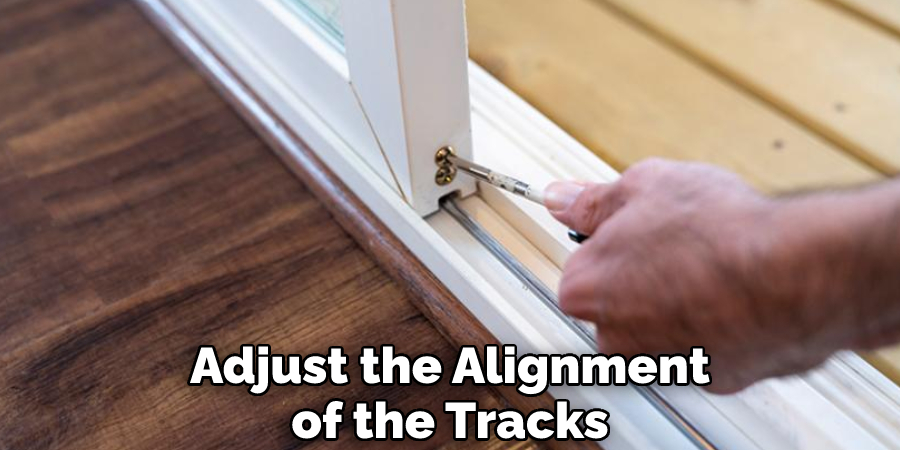Pocket door scratching can be a frustrating problem to deal with, as these doors are often located in high-traffic areas. Fortunately, you can take some simple steps to address the issue and make your pocket door look new again. Learning to fix pocket door scratching will help keep your home looking neat and tidy and prevent future damage from occurring.

One of the main advantages of fixing pocket door scratching is that it can be completed quickly and with minimal tools. This makes it ideal for those who may not have much experience or access to specialized tools. Additionally, fixing scratches on a pocket door requires no special skill; anyone with average DIY skills can complete most repairs. In this blog post, You will learn in detail how to fix pocket door scratching.
How Do You Identify What is Causing the Pocket Door to Scratch?
Before you can fix pocket door scratching, you need to identify what is causing it. If the scratch is above the floor level, it could be caused by an object or furniture being pushed up against the door. If the scratch is below the floor level, then it could be caused by a sharp corner on another piece of furniture that rubs against the door as it slides in and out.
Once you have identified the cause, you can fix the pocket door scratching. The solutions below will work for both scenarios outlined above. If the scratch is caused by an object or furniture being pushed up against the door, try adding protective padding to prevent further damage. This can be something like a thin layer of foam or cloth that you place between the object and the door.
Tools You Will Need
- Screwdriver
- Hammer
- Pliers
- Nails
- Utility knife
- Sandpaper or steel wool
- Grease or oil (lubricant)
- Metal file
- Door jamb saw
- Wood shims
Step-by-step Instructions for How to Fix Pocket Door Scratching
Step 1: Inspect the Pocket Door
The first step in fixing a pocket door that is scratching is to inspect the door, looking for any existing damage. If there is any visible damage, you should repair it before proceeding with the next steps. Next, measure the size of your pocket door so you know how much material you will need for the repair.

Step 2: Sand the Tracks and Sides of the Door
Once you have inspected and measured your pocket door, you should use a power sander to sand down any rough edges on the tracks or sides of the door. This will help reduce friction between the door and its frame when it is opened and closed.
Step 3: Apply Lubricant
Once the pocket door is properly sanded, you can apply a lubricant to the tracks and sides of the door. This will help reduce friction between the door and its frame when it moves, reducing scratching and other damage. Be sure to use a lubricant that is safe for use on your specific type of pocket door.
Step 4: Secure the Door
Finally, you should check to ensure the pocket door is properly secured in its frame. If it is not secure, it may cause additional scratching and damage when opened and closed. Ensure all screws, bolts, and other hardware are tightened securely before using the pocket door again.
Following these steps can help minimize the likelihood of your pocket door scratching and damaging its frame. Regular maintenance should be done to keep the pocket door from becoming excessively worn, scratched, or damaged.
Tips for How to Fix Pocket Door Scratching
- Ensure you wear protective eyewear and gloves when attempting to fix a pocket door scratching issue.

- Unplug any electrical devices before beginning the repair process.
- Ensure that the area is well-ventilated and free of dust, dirt, or debris before commencing work.
- Ensure that the door is securely closed and locked before beginning work.
- Follow all manufacturer instructions carefully when applying lubricant or other materials to the pocket door track.
- If a pocket door has been scratched on both sides, it may be necessary to replace the entire track assembly.
- Be sure to use only soft cloths or sponges to clean the pocket door track, as abrasive materials may further damage the sliding mechanism.
- If you have an issue that cannot be resolved with DIY solutions, it is essential to consult a professional contractor to ensure that the job is done correctly and safely.
How Do You Prevent Future Scratching of the Pocket Door?
- Inspect the pocket door for any loose screws or nails that may be causing it to rub on the frame. Tighten or replace these as necessary.
- Apply a thin layer of silicone-based lubricant to the track and rollers on both sides of the door. This will reduce the friction between them and help to prevent scratching in the future.
- If your pocket door has a guide wheel, inspect it for wear and tear. Replace the wheel if necessary, as worn-out guides can cause more friction and lead to further scratching of the door.
- Ensure any weatherstripping or insulation around the pocket door is properly installed and adjusted. This will help to reduce air leakage and debris that can cause the door to rub against the frame.
- If you feel that your pocket door isn’t opening or closing smoothly, adjust the alignment of the tracks with a wrench or screwdriver.

Following these steps will help you fix any existing scratches on your pocket door, as well as prevent further scratching in the future.
What Kind of Maintenance Do You Need to Perform Regularly to Keep Your Pocket Door From Scratching?
To keep your pocket door from scratch, it’s important to perform regular maintenance. To do this, you’ll need to check the condition of the pocket door and its tracks on a regular basis. Inspect the sliding elements for any signs of wear or damage, such as gouges, dents, or scratches. If you find any visible damage, then you’ll need to repair it immediately.
To prevent scratches from occurring in the future, make sure that you clean the track and the door regularly with mild, cleaner, or warm soapy water. This will help remove any dirt or debris that could cause a scratch when the door is opened and closed. Additionally, using a lubricant on both the tracks and the door can help ensure that it glides smoothly without any friction or scraping.
If your pocket door is made of wood, then you’ll need to take extra steps to protect it from scratches. You should use a sealant on the exposed parts of the door to help lock in moisture and prevent damage.
How Can You Get Professional Help in Fixing a Pocket Door Scratch?
Some options are available if you cannot fix the pocket door scratch yourself or want professional help. The first option is to hire a handyman specializing in home repairs and renovations. Handymen may be able to install a new pocket door frame or repair the existing one, as well as apply touch-up paint to help hide the scratch.
Alternatively, you can also hire a professional contractor or carpenter who specializes in door repair and installation. This type of professional will be able to make sure that your pocket door is correctly installed and functioning properly. They can also help with any other related repairs that may need attention, such as fixing loose screws or replacing worn door hinges.

A third option is to search online for pocket door repair and installation services. Many companies offer these services at competitive prices and may be able to help you fix the pocket door scratch quickly and easily.
Conclusion
One of the biggest disadvantages of fixing pocket door scratching is that the process can be difficult and time-consuming. As pocket doors are usually installed in tight spaces, it can be difficult to access all of the parts in order to make repairs. If the door is sliding off track, this requires even more effort as you need to lift or remove the entire door to reset the track.
In conclusion, pocket doors can be a great addition to any home. Unfortunately, they can sometimes scratch or drag on the floor when opening and closing. Luckily, there are some simple ways to fix this problem and restore your pocket door’s smooth operation. All you need is some basic tools such as screws and pliers, along with some lubricant like WD-40 or Vaseline. You can adjust how tight or lose the rollers are and use a lubricant to reduce friction and ease movement. I hope this article has been beneficial for learning how to fix pocket door scratching. Make Sure the precautionary measures are followed chronologically.


